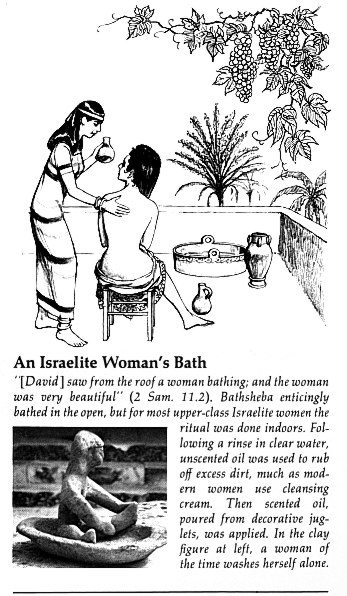
THE QUESTION OF BAPTISM BY SPRINKLING OR POURING.
"I will sprinkle clean water upon you, and you shall be clean from all your uncleanness, and from all your idols I will cleanse you" (Ezek 36:25)
| Throughout Old Testament Times The common Jewish method of "Washing" was by Pouring: |
 |
First we must note that the Catholic Church admits immersion is a legitimate form. In the same sprit of truth to Say that "Immersion is the only method found in scripture and the only legal form" is not true. The mode of baptism can in no way be determined from the Greek word "Baptizo" rendered "baptize" Some say that it means "to dip," and nothing else. That is an incorrect view of the meaning of the word. It means both
(1.) to dip a thing into an element or liquid, and
(2.) to put an element or liquid over or on it. Nothing therefore as to the mode of baptism can be concluded from the mere word used. The word has a wide latitude of meaning, not only in the New Testament, but also in the LXX (the Greek Septuagint) Version of the Old Testament, where it is used of the ablutions and baptisms required by the Mosaic law. These were effected by immersion, and by affusion and sprinkling; and the same word, "washings" (Exod. 30:17-21; Lev. 11:25; 15:8; 17:15; Heb. 9:10, 13, 19, 21; 31:22-23 and in the New testament Luke Mark 7:4; Heb. 9:10) a good example wood be Luke 11:38 explains that Jesus went to dine with a Pharisee and "The Pharisee was astonished to see that he did not first wash [the Greek word for "washed" is baptizo] before dinner." No one in ancient Israel practiced immersion before dinner, but the Pharisees "do not eat unless they wash their hands" (Mark 7:3). It can also mean "cleansing" (II Kings 5:14; Eccl. 34:25 ) "Baptizo or baptize" designates them all.
In the New Testament there cannot be found a Single Well-authenticated instance of the occurrence of the word where it necessarily means immersion. Moreover, none of the instances of baptism recorded in the Acts of the Apostles (2:38-41; 8:26-39; 9:17, 18; 22:12-16; 10:44-48; 16:32-34) favors the idea that it was by dipping the person baptized, or by immersion, while in some of them such a mode was impossible. Historians and archaeologists point out that there was Insufficient water in Jerusalem for immersion of Three Thousand on Pentecost (Acts 2:38-41) Even if there had been one, the natives of Jerusalem would scarcely have let their city's water supply be polluted by having three thousand sweaty bodies plunged into it. Also in the Deserted Area of Acts 8:26-39. Could St. John the Baptist have been physically capable of immersing all the persons who came to him for baptism? After the earthquake that released him from prison, Paul baptized his jailer and his entire family--within the jailor's house (Acts 16:32-33). Peter performed baptisms in the house of Cornelius (Acts 10:47-48), even though bathtubs and swimming pools weren't fixtures of ancient homes. Ananias baptized St. Paul were he found him in the House of Judas in Damascus, In fact, he was baptized standing up. When Ananias came to baptize him, he said: "And now why do you wait? Rise [literally, "stand up"] and be baptized, and wash away your sins, calling on his name" (Acts 22:16).
The gospel and its ordinances are designed for the whole world, and it cannot be supposed that a form for the administration of baptism would have been prescribed which would in any place (as in a tropical country, desert or in polar regions) or UNDER ANY CIRCUMSTANCES be inapplicable or injurious or impossible.
Even before the end the first century, and before the writing of the last book of the New Testament, Revelations (about 100 A.D.). The early Christians were prescribing Pouring as a proper mode of baptism:" After the foregoing instructions, baptize in the name of the Father, and of the Son, and of the Holy Spirit, in living [running] water. If you have no living water, then baptize in other water, and if you are not able in cold, then in warm. If you have neither, POUR WATER THREE TIMES ON THE HEAD, IN THE NAME OF THE FATHER, AND OF THE SON, AND OF THE HOLY SPIRIT. Before baptism, let the one baptizing and the one to be baptized fast, as also any others who are able. Command the one who is to be baptized to fast beforehand for one or two days" (Didache [A.D. 70] 7:1).This is seconded by other early Christian writings. Hippolytus of Rome said, "if water is scarce, whether as a constant condition or on occasion, then use whatever water is available" (The Apostolic Tradition, 21; [A.D. 215]).
Pope Cornelius I wrote that as Novation was about to die, "he received baptism in the bed where he lay, by pouring" (Letter to Fabius of Antioch, A.D. 251; cited in Eusebius, Ecclesiastical History, 6:43:11).
Cyprian advised that no one should be "disturbed because the sick are poured upon or sprinkled when they receive the Lord's grace" (Letter to a Certain Magnus, 69:12 [A.D. 255]). Tertullian described baptism by saying that it is done "with so great simplicity, without pomp, without any considerable novelty of preparation, and finally, without cost, a man is baptized in water, and amid the utterance of some few words, is sprinkled, and then rises again, not much (or not at all) the cleaner" (On Baptism 2; A.D. 203). Obviously Tertullian did not require baptism to be immersion, since he says on is only sprinkled and thus one comes up from the water "not much (or not at all) the cleaner." is seconded by other early Christian writings. Hippolytus of Rome said, "if water is scarce, whether as a constant condition or on occasion, then use whatever water is available" (The Apostolic Tradition, 21; [A.D. 215]).
Pope Cornelius I wrote that as Novation was about to die, "he received baptism in the bed where he lay, by pouring" (Letter to Fabius of Antioch, A.D. 251; cited in Eusebius, Ecclesiastical History, 6:43:11).
Cyprian advised that no one should be "disturbed because the sick are poured upon or sprinkled when they receive the Lord's grace" (Letter to a Certain Magnus, 69:12 [A.D. 255]). Tertullian described baptism by saying that it is done "with so great simplicity, without pomp, without any considerable novelty of
| In the Old Testament Times, Jewish Kings were anointed by the pouring of special oils on the head: |

|
preparation, and finally, without cost, a man is baptized in water, and amid the utterance of some few words, is sprinkled, and then rises again, not much (or not at all) the cleaner" (On Baptism 2; A.D. 203). Obviously Tertullian did not require baptism to be immersion, since he says on is only sprinkled and thus one comes up from the water "not much (or not at all) the cleaner."
Then there is the artistic and archaeological evidence. Many of the earliest Christian artworks depicted baptism--but never baptism by immersion! If the recipient of the sacrament is in a river, he is always shown standing ankle deep while water is poured over his head from a cup or shell. Tile mosaics in ancient churches, paintings in the catacombs, designs on ordinary household objects like cups and spoons, engravings on marble--it is always baptism by pouring. In every instance it is a shallow pool or basin in which the neophyte stands with feet immersed, while water is poured on him from an overhead stream or from a vase held by the person baptizing. . No, the entire record of the early Church--as shown in the New Testament, in other writings, and in monumental evidence--indicates the mode of baptism was not restricted to immersion. Other archaeological evidence confirms the same thing. An early Christian baptistery was found in a church in Jesus' home town of Nazareth, yet this baptistery, which dates from the early second century, was too small and narrow to immerse a person in. The oldest western fonts are found in the Roman catacombs, cisterns hewn from the tufa in the floor of baptismal chapels. Examples are to be found in the Ostrian Cemetery, where in a small shallow basin in the floor a spring wells up in the Cemetery of Pontianus, where an oblong reservoir about eighteen square feet in surface area and three feet in depth, is yet filled with water (Marucchi, Archééologie Chréétienne, II, 63); that of St. Felicitas (ibid., 304); and of St. Priscilla, where in 1901 was found a basin of particular interest on account of its presumably high antiquity as a baptismal center (Marucchi in Nuovo Bullettino, 1901, 73). That pouring water on the from overhead was the ordinary mode of baptizing during the early centuries, is a view the acceptance of which is compelled by the studies in the archaeology of baptismal fonts (de Rossi, Bullettino di Archeol., 1876, 8-15; Duchesne, Les Eglises sééparéées, Paris, 1905, 89-96).
Notes
Ritual washing, under the Mosaic Law, was frequently performed by both immersion sprinkling:
"It is a well known fact that in ancient times ritual washing was performed with either sprinkling or immersion." (Rabbi James Shoffner, Rituals of Judaism, p. 212)
"Ritual washing, under the Mosaic Law, was frequently performed with either the immersion of the individual in water, or the sprinkling of said water..." (Tracy Fox, Ph.D., A History of the Jewish people, p. 345)
"The history of sprinkling and immersion, with regards to ritual washing, can be traced back to the days of ancient Israel..." (Creso Nejhad, Ph.D., A Dictionary of Judaism, p. 153)
"As most individuals who are knowledgeable in the area of Jewish history can inform you, ritual washing in Old Testament times could be, and was, performed by either sprinkling or immersion." (Rabbi Eleazer Wein, Frequently Asked Questions About Judaism, p. 154)